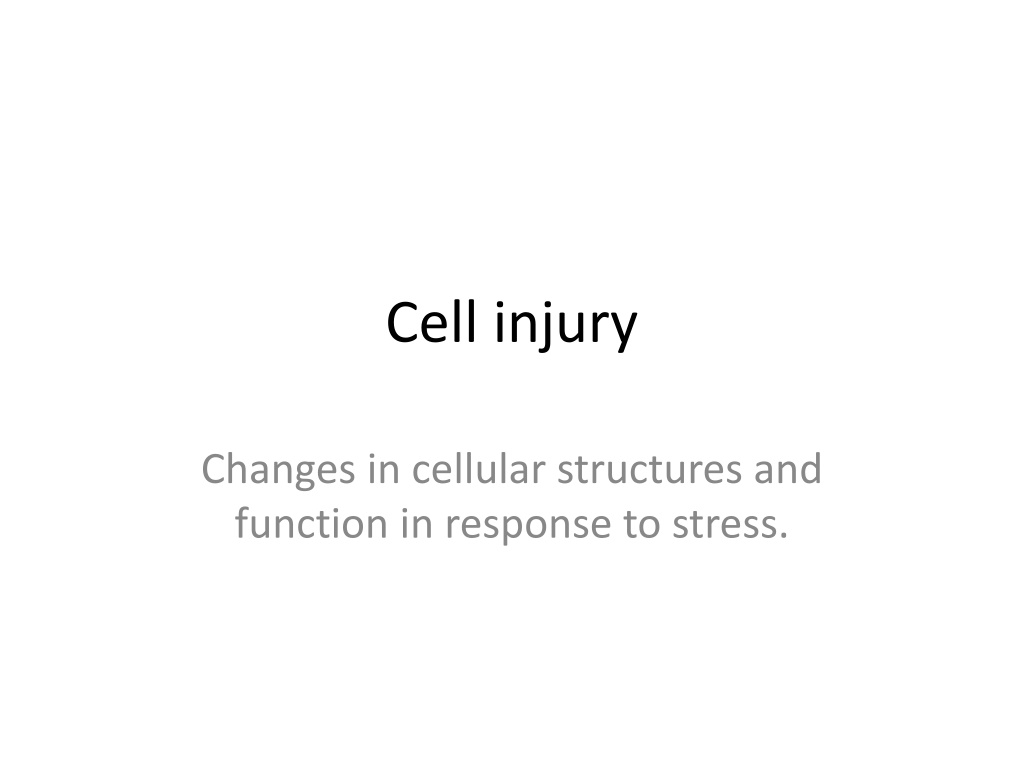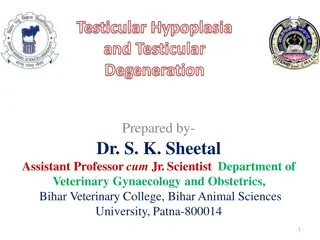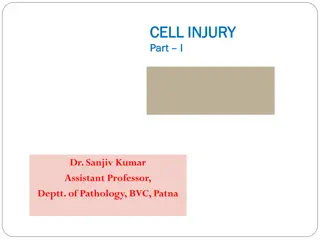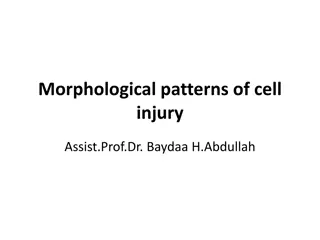Understanding Cell Injury and Degeneration in Response to Various Stressors
Cell injury can result from multiple stressors such as hypoxia, physical agents, chemicals, microbes, immunologic factors, nutritional imbalances, and aging. This can lead to reversible changes (degeneration) or irreversible changes (necrosis). Types of degeneration include cloudy swelling, hydropic degeneration, fatty changes, mucoid and myxomatous degeneration, hylalin degeneration, and amyloid degeneration, each with distinct cellular manifestations. Swift recognition and understanding of these cellular responses are crucial for diagnosis and treatment.
Uploaded on Sep 17, 2024 | 0 Views
Download Presentation

Please find below an Image/Link to download the presentation.
The content on the website is provided AS IS for your information and personal use only. It may not be sold, licensed, or shared on other websites without obtaining consent from the author. Download presentation by click this link. If you encounter any issues during the download, it is possible that the publisher has removed the file from their server.
E N D
Presentation Transcript
Cell injury Changes in cellular structures and function in response to stress.
Causes of cell injury 1. Hypoxia and ischaemia 2. Physical agents( heat and cold ,ultraviolet and truma ) 3. Chemical agents and drugs (poisons such as cyanide, arsenic, mercury; strong acids and alkalis and environmental pollutants) 4. Microbial agents caused by bacteria, rickettsiae, viruses, fungi, protozoa and parasite) 5. Immunologic agents ( hypersensitivity reactions; anaphylactic reactions; and autoimmune diseases. 6. Nutritional derangements( starvation and obesity) 7. Aging
Type of cell injury Reversible changes (degeneration) Irreversible changes (necrosis or cell death) Adaptation. Degeneration :reversal change in which the cell return to normal after remove the stress or causative agents. Ch. By. nucleus is normal.
Type of degeneration 1. cloudy swelling. 2.Hydropic degeneration. 3.Fatty changes. 4.mucoid and myxometuse degeneration. 5.Hayalin degeneration 6. Amyloid degeneration.
Type of degeneration 1. Cloudy swelling results from impaired regulation of sodium and potassium at the level of cell membrane. This results in intracellular accumulation of sodium and escape of potassium. This, in turn, leads to rapid flow of water into the cell to maintain iso-osmotic conditions and hence cellular swelling occurs
2.Hydropic degeneration :Is sever form of cloudy swelling, in which accumulation vacuoles of water in cytoplasm. Accure in liver. caused by alcohol, CCL4 toxicity and viral hepatitis.
. Grossly, the affected organ such as kidney, liver, pancreas, or heart muscle is enlarged due to swelling. The cut surface bulges outwards and is slightly opaque. Microscopically, it is characterised by the following features (Fig. 3.11): i) The cells are swollen and the microvasculature compressed. ii) Small clear vacuoles are seen in the cells and hence the term vacuolar degeneration. These vacuoles represent distended cisternae of the endoplasmic reticulum. iii) Small cytoplasmic blebs may be seen. iv) The nucleus may appear pale.
3.fatty change (steatosis) Is abnormal accumulation of fat in cytoplasm of cell. It is especially common in the liver but may occur in other non-fatty tissues like the heart, skeletal muscle, kidneys (lipoid nephrosis or minimum change disease) and other organs.
Causes of fatty changes 1.increase fatty acid.(obesity.starvation) 2.increase fatty acid synthesis in the liver 3.decrease oxidation fatty acid (hipoxia and anemia) 4.increase esterification of fatty acid to triglycerides( as alcoholsim) 5.decrese synthesis of apoprotin (mal nutrition and alcohol or toxicity)
sings Grossly.. Liver enlarged Soft with round borders. Yellow in color. Greasy to touch Microscopically.. Liver cell accumulate fat which appear in H andE stained.as clear vacules. These vacules small and then fuse toform large vacules which push the nucleuse to one side of cell .signet ring cell.
4.Mucinous and myxomatous degeneration Normally.: Mucin secreted by mucous cell of mucous glands.(respiratory tract and GIT) Mucin, a glycoprotein, is its chief constituent. Mucin is normally produced by epithelial cells of mucous membranes and mucous glands, as well as by some connective tissues like in the umbilical cord. By convention, connective tissue mucin is termed myxoid (mucus like). Both types of mucin
Microscopically.. Pale blue stain with Hand E staining. CT/(myxomatous) Few star shape with processes seprated by blue mucin with round hyperchromatic nucli. Cytoplasim is pale. Groslly.. Pale grey transparent slimy fluid.
sites 1.Epithelial (mucoid) :Catarrhal inflammation of mucous membrane (e.g. of respiratory tract, alimentary tract, uterus). 2. Obstruction of duct leading to mucocele in the oral cavity and gallbladder. 2.C T/(myxomatous) present in: In sub cutaneous tissue of myxoma and C T of tumer.
5. Hyaline degeneration means deposition glassy, homogeneous, eosinophilic protein material either inside cell or in connective tissue. A:Cellular haylinosis: 1,mallary ..liver of chronic alchoholism 2.corpora amylaca ..prostate of old male 3.russel bodies plasma cell in scleroma.
B: connective tissue hyalenosis 1. wall of blood vessel. 2. old scar, thrombi and tumers.
6.Amyloidosis Amyloidsis is condtion in which theres depostion of abnormal extra cellular fibrillar protein( amyloid) in many tissue. In general amyloid present near basement membrane of blood vessels.
Grossly: appear brown with iodin and become blue with add selphoric acid Microscopically.. Appear eosinophilic with H and E stain. Amyloid stain red by congo red It also demonstrate by metachromatic stain (genten ,methyl, And crystal violet)























